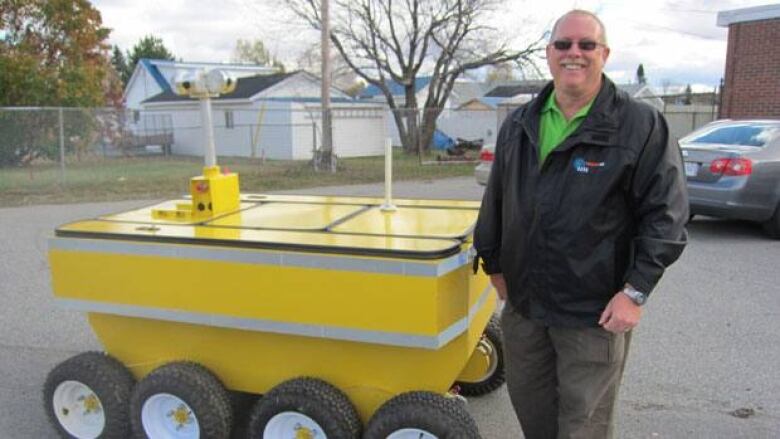Sudbury robot goes to Chile
Robot designed with recent mining disasters in mind

A robot designed and builtin Sudbury will soon be put to work in an undergroundChilean mine.
The state-owned copper mining company CODELCO is interested in the new technology for a number of reasons and chief among them is mine safety.
In August 2010, a mine collapsed in northern Chile, trapping 33 miners underground for more than two months. They were eventually rescued.
"They were so far in the mine, they were lucky to be found, and look how long it took to get them," said Greg Baiden, chief technology officer withPenguin Automated Systems, the company behind the robot.
"So having some capability like this has caught their attention. We've had meetings with their senior safety people. Some of them were involved in the rescue."
Baiden said the robot was also designed with some other recent mining disasters in mind.
"In the states, particularly in the coal mines, the problem they had was that they couldn't re-establish the mine quickly enough to get to the people. To do it safely, you have to make sure the ventilation is in the right place you [have to] build your way back in. So it can take a month or something to get to where they need to be."
Reconnaissance robot
Penguins research centre is on the outskirts of Sudbury. Baiden toured through the facility that was once a Catholic elementary school. A 25-person team works there now.
Baiden showed off a machine that was cutting a pivot for the wheels while, in another room, students were working on the frame.
"It's a reconnaissance robot, so it can go in and give you what the falls of ground look like," Baiden said.
"We have the ability to put ventilation sensors on it, so we can tell the condition of the air. And it'll cover such difficult terrain that it can go into situations where maybe even people can't go, and it's got the ability to carry a load."
Over the years, dozens of students from local colleges and Laurentian University have had a hand in the robot's evolution.
Sensors help detect hazards
Stephan Luoma was one of those students, but now he works for Penguin as a programmer.
Heused a joystick to maneuver the robot remotely during an outside test run.
"So if you're walking, you have a feel for where you are. But if you're tele-operating something, you lose that ... intuition.By using these sensors we're able to know where we are."
According to Luoma, as mines get deeper, the work environment gets less hospitable.
The temperature increases and so does the rock pressure.
"When it's underground, or in any type of challenging environment, there's areas where people simply can't go," he continued.
"So being able to send a robot in those places is really critical. Using our inertial navigation system you can find out the position with enough precision that you can actually make a map."
'You can have a good understanding on what's there before you send people in' Stephan Luoma, Penguin Automated Systems programmer
That map could detail where pockets of poisonous gas may be, or indicate the physical profile of a tunnel.
"You can have a good understanding on what's there before you send people in," he said.
Chilean mining company CODELCO has offered $3-million to buy the robot.
For Luoma, there's satisfaction in seeing a research project become a commercial product.
"It's always nice to see your stuff in the field, especially in challenging environments."












_(720p).jpg)


 OFFICIAL HD MUSIC VIDEO.jpg)
.jpg)



























































































